The sun is shining and the birds are singing out in the garden this morning.
We're making the most of the gentle weather, settling the spring accounts and preparing for another great summer. So lets take the radio out into the garden and get things going.
It's time to:
Admire
Peak Jacaranda flower in Sydney and the mauve carpets are just as impressive. We just love this time of year.
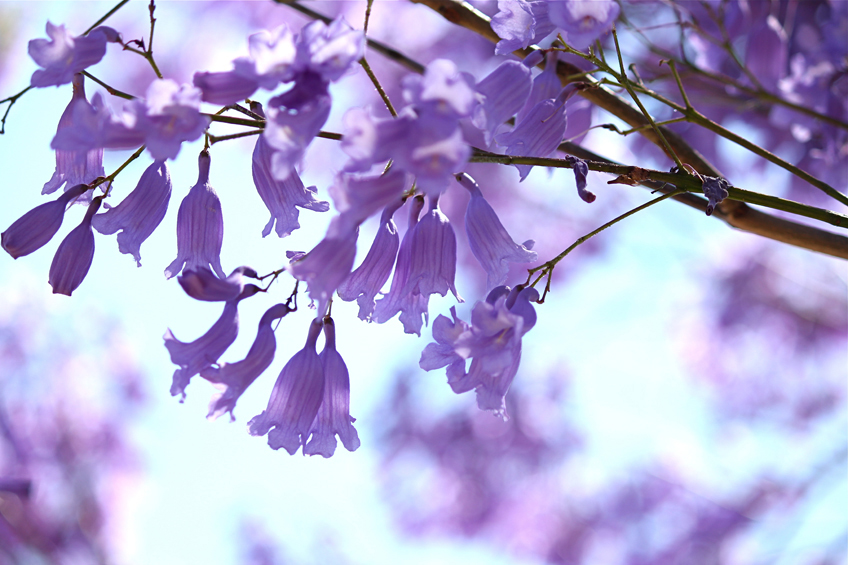
Sydney is enjoying peak Jacaranda. Photo - Miwa in oz / Shutterstock.com
Mulch
Mulch garden beds thickly to keep moisture in and weeds out over summer. Make sure the soil is moist when you lay the mulch.
Pests
Check for pesky azalea pests – lace bug, red spider and thrips. Thoroughly spray with the hose under the leaves to discourage them, as they do like dry
conditions. A Confidor tablet planted in the soil will keep them at bay.
Take action against snails and slugs. Sprinkle Multiguard pellets around vulnerable plants, entice them to drown in saucers of beer, or drop them into
a bucket of salty water on a damp evening when they are out in force.
Plant
Plant out dahlia tubers, and use stakes to keep them upright as they grow.
Prune
Prune climbing roses that flower once a year in spring. Cut back laterals to a few healthy ‘eyes’ and remove old canes at the base to allow new growth.
Repot
Repot orchids if they have become overcrowded. Use a sharp knife to divide the plants and to cut out any soft old pseudobulbs. Repot into clean containers
with fresh orchid mix.
The Bush Garden
Brachychiton x roseus
The Pink Flowering Flame Tree, an artificial hybrid between B. acerifolius (Illawarra Flame Tree) and B. populneus (Kurrajong), was sold for decades as
B.X hybridus but further research over last 40 years explains the origins and correct name for this stunning flowering native tree. There are many
hybrids sold in Australia from these same origins including B. X ‘Belladonna’, B. X ‘Jerilderie Red’, B. X ‘Bella Pink’, and B. X ‘Coral Pink’. The
B. ‘Jerilderie Red’ was first described by the famous botanist Baron von Mueller in 1881. He was Victoria’s Botanist and Director of the Royal Botanic
Gardens Melbourne and instrumental in encouraging the Giles and Burke & Wills expeditions. In fact he discovered and named over 800 native plants
himself. The hybrid flame trees have many names but very similar habits of growth and flower colour.
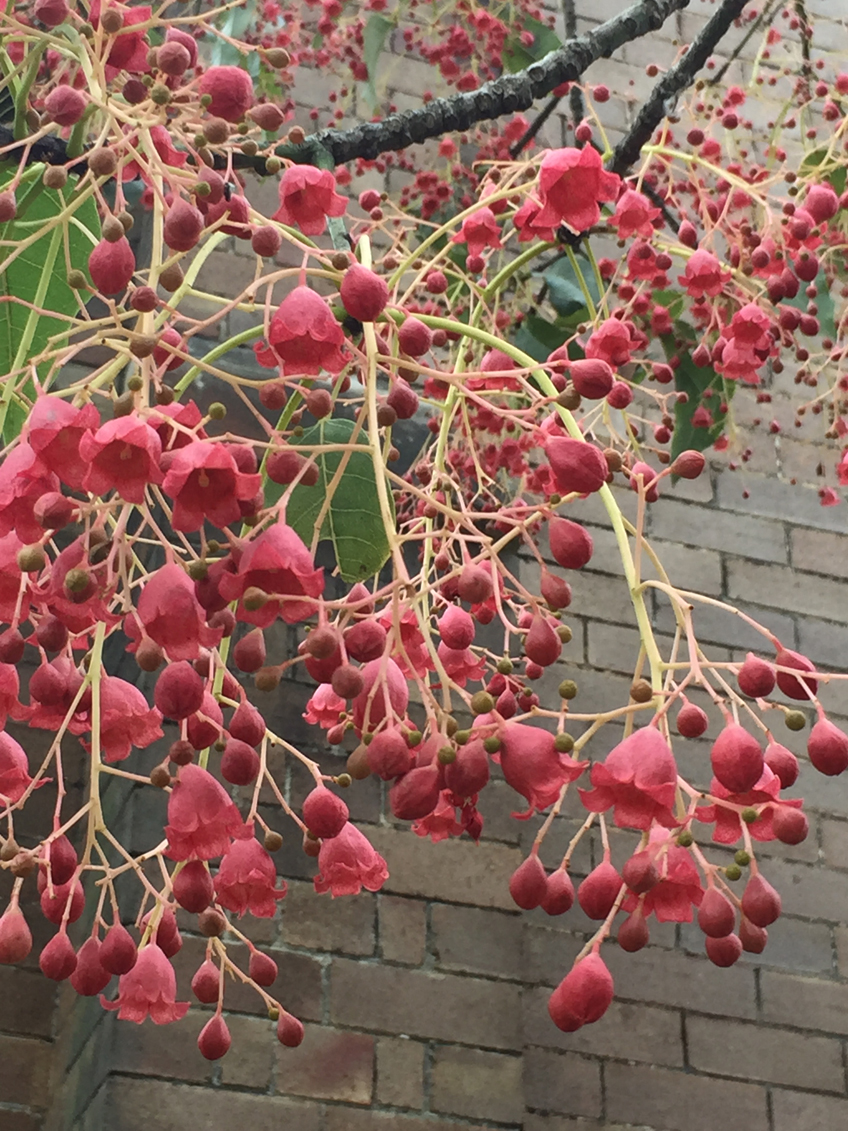
Brachychiton flowers up close. Photo - Graham Ross
Highly regarded nurseryman Merv Hodge used to sell these hybrids in the 1970s as did Kerry Rathie from the Brachychiton and Allied Genera Study Group of
the Australian Plant Society. In the 1970’s there were also hybrids coming onto the market from NSW and Victoria which were in essence clones selected
for their stunning flower display then grafted to retain their beauty in nursery stock. In fact Kerry Rathie wrote a book about Brachychitons.
Names for these hybrid cultivars has been confusing for over 100 years but some common sense was determined by Gordon Guymer in his research Ph. D thesis
published in 1988.
Everyone recognises the brilliant red flowering Illawarra Flame tree that often joins the Jacaranda and the Silky Oak in flower at this time in late spring
but the man-made hybrids are often pink in colour but being grafted are more reliable flowerers than those grown from seed which may take 15+ years
to flower.
Brachychiton roseus is a deciduous tree losing its leaves generally in autumn but often not until winter. The tree can easily grow to 7-8m in height and
4-6m wide on a single trunk we call mono-podal but with little branching for the first 3m therefore taking up little ground space in a garden but beautifully
displaying its sensational spring/summer flowers. The lush- lime green leaves appear after the flowers creating welcome summer shade.
Humphris Nursery in Melbourne sells many hybrids but local garden centres and nurseries also often carry advanced trees.
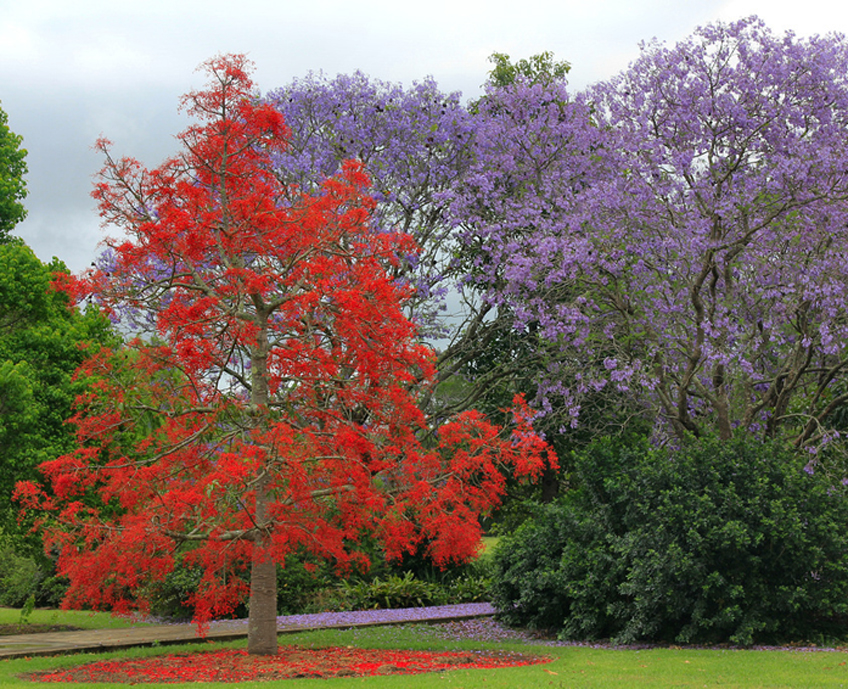
Brachychiton and Jacaranda share flowering season and look incredible together.
Bugwatch
Red Spider or two spotted mite
A minute insect that commonly sucks the sap from the leaves of ornamentals like azaleas, all the rhododendron family, roses, fuchsias, viburnums, and orchids
and edible crops like tomatoes, beans, cucumbers, strawberries, pome fruit like apples, and stonefruit including peaches.
The tiny ‘spider-like’ insect belongs to its own class of mites and is not troubled by regular insecticides, in fact attempted control in the past with
regular pesticides has helped increase populations of mites by killing beneficial insects that help control the pest.
Since WW2 garden controls of red spider mites have recommended dangerous and toxic miticides which have all been sensibly removed from garden centre shelves.
Because the tiny insect is nearly always found on the reverse of the host plants’ leaves, the first sign of damage are silvery or yellowing leaves indicating
the insect has sucked the chlorophyll in the process.
The insect has two dark spots on its sides of a green body that in autumn is a distinct red colour hence its common name.
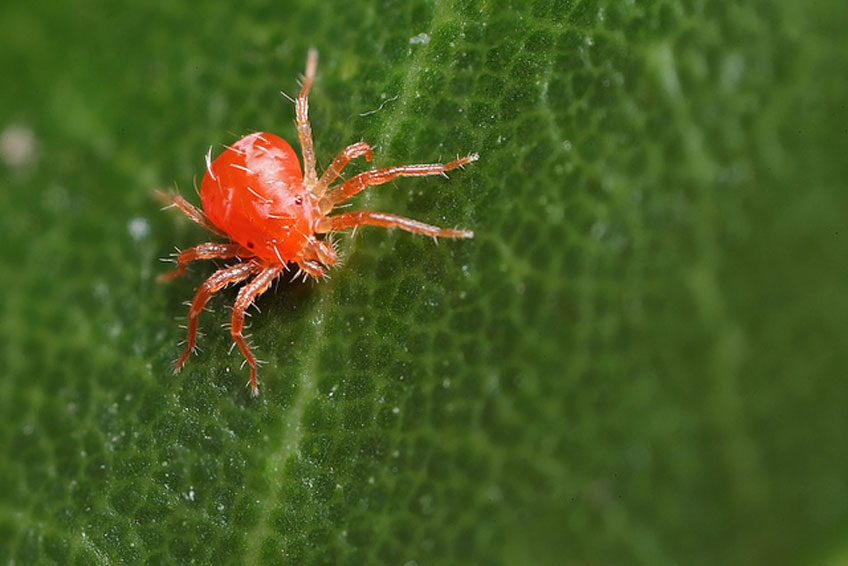
Red spider mite. Photo - snakesandspiders.com
In heavy infestations a fine webbing will be visible especially on roses but will be evident on other plants.
The end result of severe mite attack will be discoloured leaves dropping, weakened plants and a general lack of vigour and poor performance.
Controls
Organic & Cultural Methods
Gardeners who have a compost heap, recycle garden and kitchen waste, manure mulch garden beds and use minimal chemical pest control will encourage populations
of good predatory mites to balance the attack of the pest mite.
Two spotted mites prefer hot, dry conditions so a sprinkler, when water restrictions allow, placed under shrubs in the morning will discourage the mites.
Keeping plants well fertilised, watered and growing vigorously will help deter mites.
OCP and other companies across Australia have Backyard Buddies, mail-order beneficial predatory mites to control the pest.
Because the harmful insect is found primarily on the reverse of the leaf, sprays will need to be applied specifically to this area but they work differently
to old fashioned traditional toxic ‘knockdown’ chemicals.
Yates Nature’s Way Vegie and Herb Spray or Natrasoap is a potassium soap that restricts the breathing pores of the insect and dehydrates the pest.
Eco Oil smothers the mite insect and the eggs and effectively controls the pest with the bonus Hippo Enhanced formulation encouraging beneficial insects.
As we’ve often mentioned on the Garden Clinic Eco-Neem, another organic spray will also control red spider or two spotted mites but works in two ways by
suppressing the mites appetite starving them and limiting the insects growth. While it is registered in Australia for use on ornamentals it is safely
registered in New Zealand and the USA on edibles.
Because the female mite repeats her egg laying process throughout the seasons repeat sprays will be necessary.
The Potted Garden
Rangoon Creeper
Last week a 4BC asked about his Quisqualis or Rangoon Creeper. I remembered the plant from many years ago as a very attractive climber with fragrant tubular
flowers in late spring/ early summer coloured white, pink and red. It's a vigorous climber now called Combretum indicum.
Native to the forests of India, Malaysia and the Philippines and naturalised in tropical climates in Asia.
It appears in early plant catalogues in Australia from the 1860's. It is still seen as a cover of chain wire fences in gardens of warm and temperate climates.
In Asia the root and fruit is still used as a herbal medicine for a wide range of illnesses.

Rangoon Creeper. Photo - Graham Ross
In the Veggie Patch
Lollipop Tomato
We launched the new Lollipop tomato on the Garden Clinic earlier this year.
A vigorous, 2m tall grower is now producing very heavy bunches of fruit 30-40 in number.
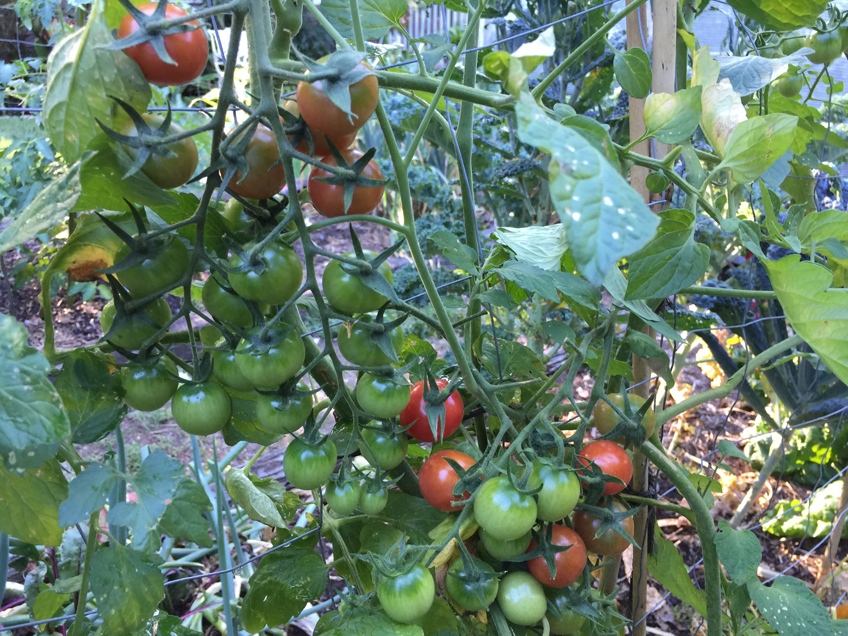
The Lollipop tomato promises to be very productive. Photo - Graham Ross
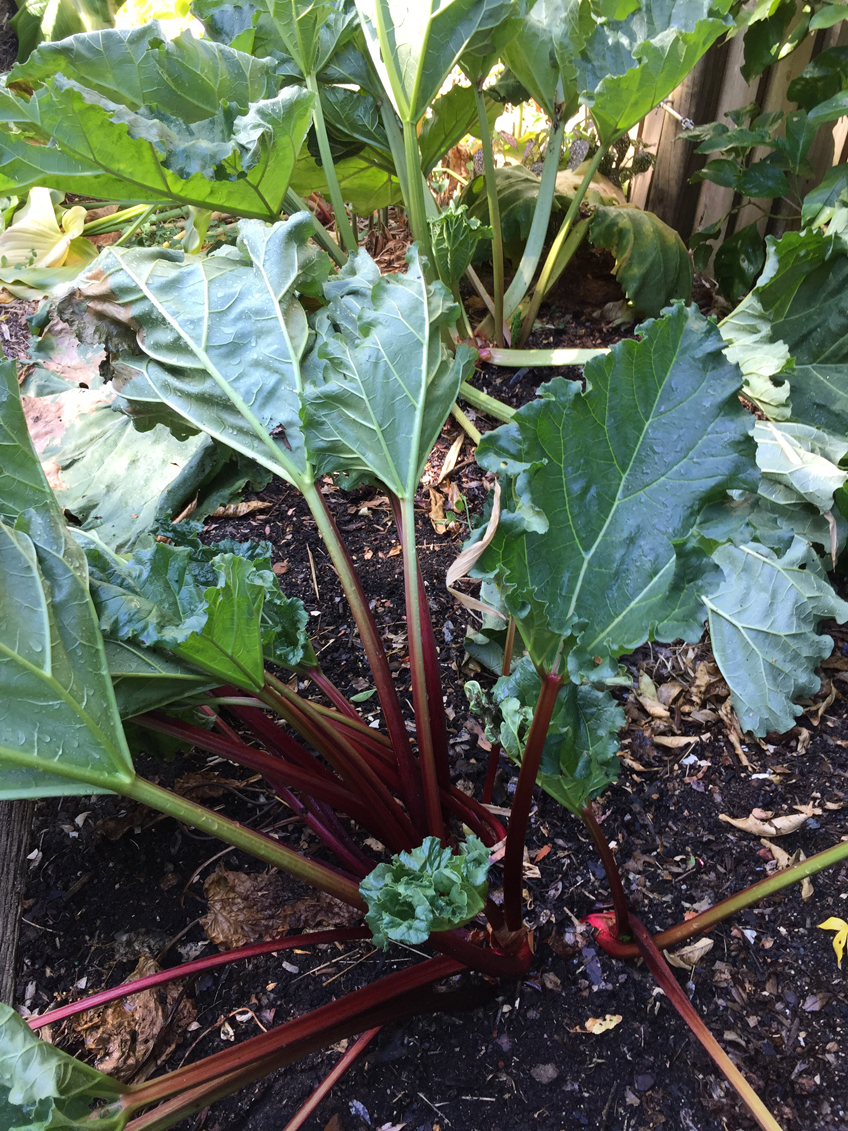
Another beaut performer in the veggie patch is my red and green rhubarb! Photo - Graham Ross
Garden News
Mikey the Powerful Owl
Regular listeners will be well aware of Mikey, our fine feathered friend and resident of the Byles Creek area of Sydney. Mikey is now the star of a new
book by Georgia Cameron and photographer, Michael Bianchino entitled "Mikey the Powerful Owlet: Saving Byles Creek Valley". The book features many
of Michael's incredible photographs and is written from Mikey's perspective.
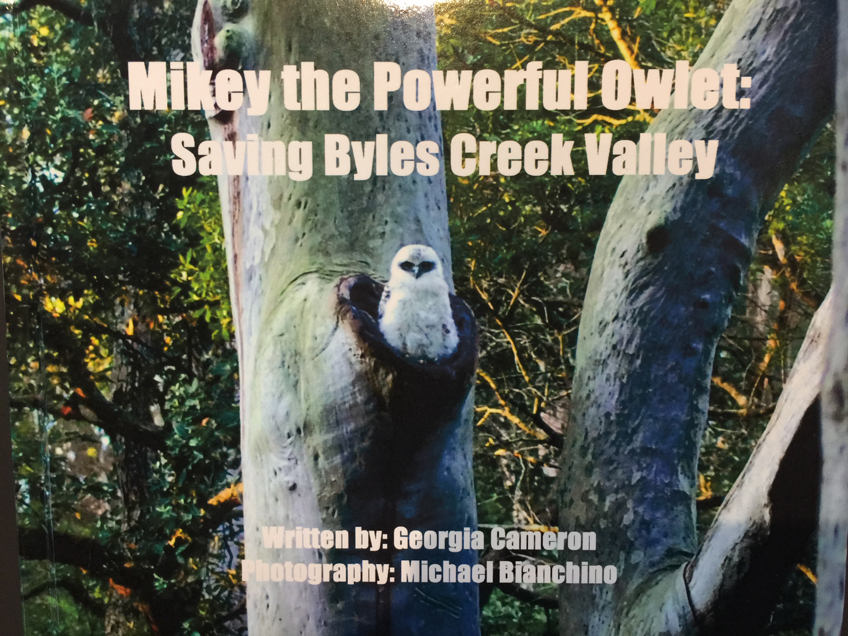
Sadly Mikey's habitat is still under threat from development.
The powerful owl (Ninox strenua) is a species of owl native to south-eastern and eastern Australia, the largest owl on the continent. It's is the top nocturnal
predator of the forests and woodlands in its range. About 75% of the diet of the powerful owl is made up of arboreal mammals like possums.
The powerful owl breeds in the Australian winter, with breeding occurring mainly in May and June and brooding at the nest into September. The breeding
territory of powerful owls are large. Even when food is abundant, territories are at least 800 to 1000 ha. When food is scarce, territories tend to
be larger. On average, nests of breeding pairs are found from 5 to 20 km (3.1 to 12.4 mi) apart. The nest is most often a large hollow in a tree.
And this is the major problem for the powerful owl. On the New South Wales Threatened Species Conservation Act the powerful owl is scheduled as "Vulnerable",
mainly due to habitat destruction.
These owls do not do as well in heavily developed areas or in monocultures even if the plantation is made up of a native tree. This is largely because
its prey is dependent on native and diverse forests, and because the owls have very particular needs with regards to roosting hollows.
To order call The Children's Bookshop to order 02 9481 8811. All proceeds go to saving Mikey, and other native animals in the Byles Creek valley.
Come away with us
Gardens of China
Journey back in time to the Middle Kingdom, a place where child emperors ruled, wonders of the world were built and the exquisite peony was the flower
of royalty. The China tour explores the birthplace of ornamental
horticulture as we know it. A fascinating tour in an incredible country
Enjoy guided tours of Beijng, Xi’an, Shanghai, Hangzhou and Suzhou. Visit the Forbidden City, Summer Palace, Beijing Botanic Garden, Ming Tombs & Sacred
Way, Great Wall, Kung Fu Show, Temple of Heaven, Tiananmen Square, Terracotta Warriors, Shanxi Museum, Tang Dynasty Show, Longmen Grottoes, Peony Festival
Garden, Guo’s Villa, West Lake cruise, Lingying Buddhist Temple, Humble Administrator Garden, Master of Nets Garden, Lingering Garden, Tiger Hill,
Tongli Village, Shanghai Botanic Garden, Yu Yuan Garden, Jade Buddha Temple, Shanghai Museum, Jinmao Tower, and Huangpu River Cruise.
Fully escorted by our trusted Chinese National Guide, Sam Liu who has escorted the tour for over 10 years, and Ross Tour Horticultural Guide, Paul Urquhart.

One of the many gardens to see in China 2016, Lingering Gardens in Suzhou.
If you would like to join us in China next year go to the Ross Tours website, or call Royce or Roslyn at Ross Tours on 1300 233 200.